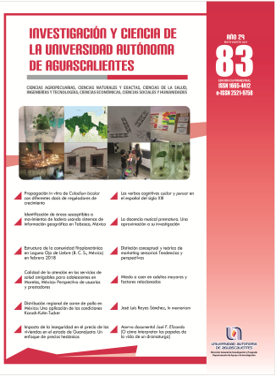Fear of falling in older adults and related factors
DOI:
https://doi.org/10.33064/iycuaa2021833751Keywords:
fall, fear, independence, balance, limitation of activities, older adultsAbstract
The fear of falling in the elderly is a relevant issue and in turn complex to discuss, so it is necessary to define it and review its related factors clearly. The importance that this term has for the elderly and people around them highlights that it is not only fear of falling after having fallen, but even before it happens or long after the first event, it is relevant to review the consequences of the same fall, such as isolation, fragility, loss of independence and fear of carrying out their daily activities. The concept of fear of falling has gained relevance, so the objective of this article is to define the “fear of falling” in older adults and review the factors related to it.
Downloads
References
Abdala, R. P., Barbieri Junior, W., Bueno Júnior, C. R., & Gomes, M. M. (2017). Padrão de marcha, prevalência de quedas e medo de cair em idosas ativas e sedentárias. Revista Brasileira de Medicina Do Esporte, 23(1), 26–30. https://doi.org/10.1590/1517-869220172301155494
Abyad, Abdulrazak; Hammami, Sonia Ouali, (2017). Fear of falling in the elderly- an emerging syndrome. Middle East Journal of Age and Ageing, 14(3), 16–25. DOI: 10.5742/MEJAA.2017.93092
Alcalde Tirado, Pablo (2010). Miedo a caerse. Rev Esp Geriatr Gerontol. Enero-febrero 2010, Volumen 45 Número 1, páginas 38–44.
DOI: 10.1016/j.regg.2009.10.006
Bhala, R. P., O'Donnell, J., & Thoppil, E. (1982). Ptophobia. Phobic fear of falling and its clinical management. Physical therapy, 62(2), 187–190. https://doi.org/10.1093/ptj/62.2.187
Curcio, C. L., Corriveau, H., & Beaulieu, M. (2011). Sentido y proceso del temor a caer en ancianos. Hacia la Promoción de la Salud, Volumen 16, No.2, julio - diciembre 2011, págs. 32 – 51. Disponible en:
https://www.researchgate.net/profile/CarmenLucia_Curcio/publication /262737968_Sentido_y_proceso_del_temor_a_caer_en_ancianos/links/ 00b7d53a9a12bc90cb000000/Sentido-y-proceso-del-temor-a-caer-en-ancianos.pdf
Curcio, Carmen-Lucia & Montes, Fernando (2012). Temor a caer en ancianos: controversias en torno a un concepto y a su medición. Hacia La Promoción de La Salud, 17(2), 186–204. Disponible en:
https://www.researchgate.net/publication/262463321_fear_of_falling _in_the_controversy_around_a_concept_and_its_ assessment
Deshpande, N., Metter, E. J., Lauretani, F., Bandinelli, S., & Ferrucci, L. (2009). Interpreting fear of falling in the elderly: what do we need to consider? Journal of geriatric physical therapy (2001), 32(3), 91–96. https://doi.org/10.1519/00139143-200932030-00002
Dewan, N., & MacDermid, J.C.(2014). Fall efficacy scale-International (FES-I). Journal of Physiotherapy, 60(1), 60. https://doi.org/10.1016/j.jphys.2013.12.014.
Encuesta Nacional de la Dinámica Demográfica (2018). Encuesta Nacional de la Dinámica Demográfica 2018: ENADID: informe operativo y de procesamiento / Instituto Nacional de Estadística y Geografía--México: INEGI, 2019. Disponible en: https://www.inegi.org.mx/ contenidos/programas/enadid/2018/doc/resultados_enadid18.pdf
Gandoy-Crego, M., & López-Sande, A., & Varela González, N., & Lodeiro Fernández, L., & López Martínez, M., & Millán-Calenti, J. C. (2001). Manejo del síndrome post-caída en el anciano. Clínica y Salud, 12(1),113-119. [fecha de Consulta 15 de febrero de 2021]. ISSN: 1130-5274. Disponible en: https://www.redalyc.org/articulo.oa?id=1806/180618320006
García B. Carlos E. (2012). Evaluación y cuidado del adulto mayor frágil. Revista Médica Clínica Las Condes, Volumen 23(1), págs. 36-41.
DOI: 10.1016/S0716-8640(12)70271-7
González C, Gisela, Marín L, Pedro Paulo, & Pereira Z, Gloria (2001). Características de las caídas en el adulto mayor que vive en la comunidad. Revista médica de Chile, 129 (9), 1021-1030. https://dx.doi.org/10.4067/S0034-98872001000900007
Jiménez Buñuales, M.ª Teresa, González Diego, Paulino, & Martín Moreno, José M.ª. (2002). La clasificación internacional del funcionamiento de la discapacidad y de la salud (CIF) 2001. Revista Española de Salud Pública, 76(4), 271-279. Recuperado en 17 de febrero de 2021, de http://scielo.isciii.es/scielo.php?script=sci_arttextypid=S1135-57272002000400002ylng=esytlng=es.
Kendrick D, Kumar A, Carpenter H, Zijlstra G, Skelton DA, Cook JR, Stevens Z, Belcher CM, Haworth D, Gawler SJ, Gage H, Masud T, Bowling A, Pearl M, Morris RW, Iliffe S, Delbaere K. Exercise for reducing fear of falling in older people living in the community. Cochrane Database of Systematic Reviews 2014, Issue 11. Art. No.: CD009848. DOI: 10.1002/14651858.CD009848.pub2
Lluis Ramos, Guido Emilio. (2013). Fragilidad y asociaciones de riesgo en adultos mayores de una comunidad urbana. Revista Cubana de Medicina Militar, 42(3), 368–376. Revisado en: https://1library.co/document/6qm95d4y-fragilidad-asociaciones-riesgo-adultos-mayores-comunidad-urbana.html
Tinetti, M. E., & Powell, L. (1993). Fear of falling and low self-efficacy: a case of dependence in elderly persons. Journal of gerontology, 48 Spec No, 35–38. https://doi.org/10.1093/geronj/48.special_issue.35
Tinetti, M. E., Richman, D., & Powell, L. (1990). Falls efficacy as a measure of fear of falling. Journal of gerontology, 45(6), P239–P243. https://doi.org/10.1093/geronj/45.6.p239
Velázquez, G., Montes, M., & Mazadiego, E. (2013). Asociación del síndrome de temor a caerse, actividades y participación en los adultos mayores. Rev Mex Med Fis Rehab. 2013;25(2):43-4. Disponible en: https://www.medigraphic.com/pdfs/fisica/mf-2013/mf132b.pdf
Downloads
Published
How to Cite
Issue
Section
Categories
License
Copyright (c) 2021 Raymunda Catalina Ocampo Dorantes, Elsy del Carmen Quevedo Tejero, Raúl Fernando Guerrero Castañeda

This work is licensed under a Creative Commons Attribution-NonCommercial-ShareAlike 4.0 International License.
Las obras publicadas en versión electrónica de la revista están bajo la licencia Creative Commons Atribución-NoComercial-CompartirIgual 4.0 Internacional (CC BY-NC-SA 4.0)









